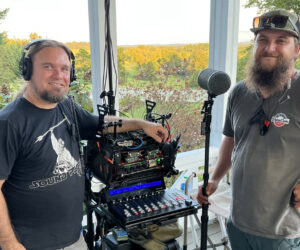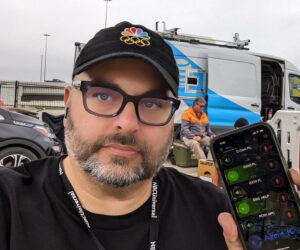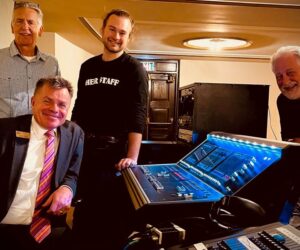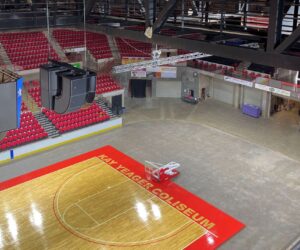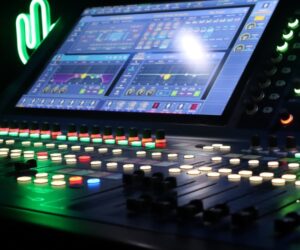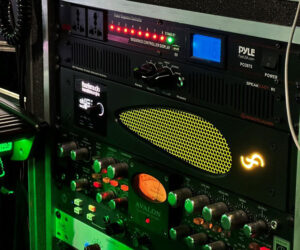In an ideal world, sonic perfection would be the sole consideration shaping sound system design. In reality, however, it’s a very rare installation in which budget doesn’t play a major role.
Fortunately for hockey fans in Duluth, Minnesota, using Electro-Voice EVA line arrays for the brand new AMSOIL Arena turned out to offer the best possible coverage and intelligibility while actually reducing overall purchase and installation costs compared to the alternatives.
Home to the University of Minnesota Duluth (UMD) Bulldogs men’s and women’s hockey teams, the all-purpose AMSOIL Arena is part of the Duluth Entertainment Convention Center on the city’s downtown Lake Superior waterfront.
The complex also includes exhibit halls, a symphony hall, an Omnimax Theater, and another arena. One of the first LEED certified arenas in the world, the AMSOIL Arena seats 6,600 for hockey and ice shows, and more than 8,500 for concerts and other entertainment. Its sound system was designed and installed by TSI Technology Solutions LLC, the systems division of TSI Global LLC, in St. Charles, Missouri, with consulting provided by Gary White of WHJW in Dallas.
“The budget for this job was smaller than what we typically have to work with for a sports stadium or coliseum,” says Scott Durham of TSI, “so we had to be creative. We wanted to hang the least amount of speakers from a limited number of points, but still achieve nice, even coverage. The EVA line arrays’ coverage is fabulous.”
The original design concept for the system, Durham says, involved 24 multi-cabinet hangs throughout the arena.
“That’s what’s commonly done in sports stadiums, but when we factored in the cost of hanging from that many points, it turned out to be more cost-effective to go with a solution of 12 line arrays. And, when we did the EASE modeling, we realized that the arrays would also give us more even coverage across the seating area.”
The key to the success of the design, Durham says, is the way the arrays were hung. “We flew them at steep angles right above the seats. The speakers are actually fairly close, about 55 to 65 feet, but we get very smooth coverage. Unlike a lot of arenas I’ve been in — some of which I’ve actually worked on — the sound is exactly the same from the bottom seat right up to the top. So whether you’re in the really expensive seats or all the way up, there’s no loss of quality. And that was our goal.”
Durham credits Electro-Voice technical services, particularly Robert Deyarmond and George Georgallis, as being instrumental in validating the overall design concept and suggesting modifications that yielded improved coverage. “I’ve worked with EV on multiple projects over the past five years,” he says, “and, compared to all the major manufacturers that I deal with, their engineering support is bar-none the best.”
The arrays are each composed of either four or six Electro-Voice EVA-2082S full-range dual-element line array modules, with 64 used in all. “We went with Electro-Voice arrays primarily because of the EV horn,” Durham says. “We needed incredible intelligibility for voice, and they build an amazing horn. Their array horns are unbeatable compared to anything on the market at less than $5,000 per box. As for EVAs in particular, we chose them because the arrays were close enough that we could still get quality sound with a smaller, less obtrusive cabinet, and that also gave us quite a cost savings.”
The system also includes eight EVH-1152S loudspeakers used as downfills for the ice, and a pair of FRi-2082 full-range, low-profile loudspeakers that provide fill under a couple of small overhangs. “Subwoofers were not specified as part of the design,” Durham notes, “but when we tested the system it ran clean up to 116 dB, A-weighted. So for concerts, if you wanted to, you could just bring in subs and run with the installed system.”
System control and processing is provided by four Electro-Voice NetMax N8000 Digital Matrix Controllers operated via three Electro-Voice IRIS-Net touch panels. The system is powered by 24 Contractor Precision Series amplifiers, each equipped with an RCM-810 DSP module to enable monitoring and amp switch-over.
“The biggest factor in choosing EV amps,” Durham says, “was their very low rate of failure and replacement. In a big stadium, that gets to be very costly. With EV amps, we typically have no failures or problems whatsoever. And the CPS amps have a very low power draw for their output, which actually helps with the LEED certification of the building.”
With the arena in regular operation as of the start of the year, the Electro-Voice system is proving that budget-friendly cost is no impediment to superior performance. “Our customers at DECC have been pleasantly surprised at both the sound quality and the amount of SPL that the PA can put out cleanly,” Durham says. “They are extremely pleased and happy with this system.”









